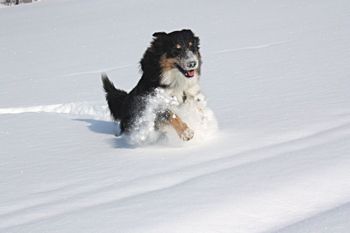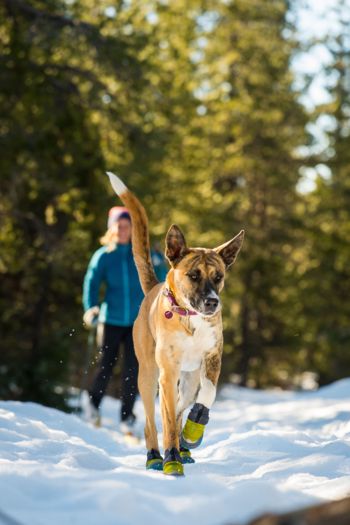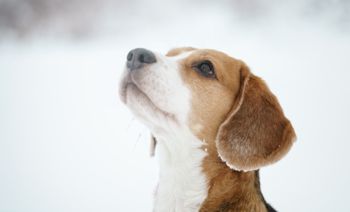There are many ways in winter to get enough exercise outdoors with your best friend and – despite the cold – have lots of fun. One of them is snowshoeing, which leads off the beaten track into the quiet, fascinating wonderland of winter. With the snow crunching under your feet and no other sound to be heard from the valley or the wintry forest, then it’s easy to become mindful and connect to the canine soul beside you.
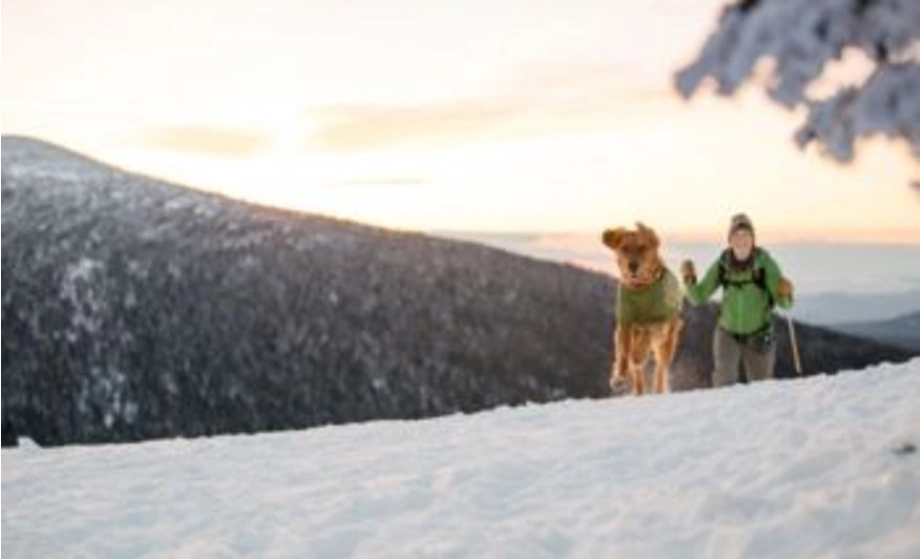
Is there anything more beautiful than hiking through the snowy landscape together with your dog and enjoying the fresh mountain air?
Where can you go snowshoeing with a dog?
Either take a special hiking trail route or break trail yourself. There are now signposted snowshoe hiking trails in many winter sports areas.
- Take care! It is crucial to find out in advance what the leash requirement is. If you are unsure, it is better to leash your dog before getting into trouble with the forestry office or the district hunter.
Observe leash regulations and protection zones
In the case of untrained dogs, leashing is compulsory in any case for the benefit of the forest fauna! In addition, hunters and foresters are very annoyed by poaching dogs. But don’t worry, if you stick to a few rules in the forest, you are guaranteed to have fun with your dog and your snowshoes.
Leashing is a fundamental prerequisite in any case so that the dog does not go rummaging or run further away from its owner. An uncontrolled dog can be hazardous for wild animals, especially in winter. If they are startled or injured, this game can perish in the snow due to exertion of its fight or flight instinct. We have compiled a separate article on what you need to bear in mind regarding protection zones in winter.
10 tips: What to look out for when snowshoeing with your dog!
Just grab your snowshoes, your best buddy and off you go? That’s not a good idea! Even if it’s just a short hike that may not be a real challenge for you, you still have your dog with you, and he should have at least as much fun as you do. To ensure that your first snowshoe tour together with your dog is a success, I have put together some information that you should think about before heading out into the backcountry with your dog.
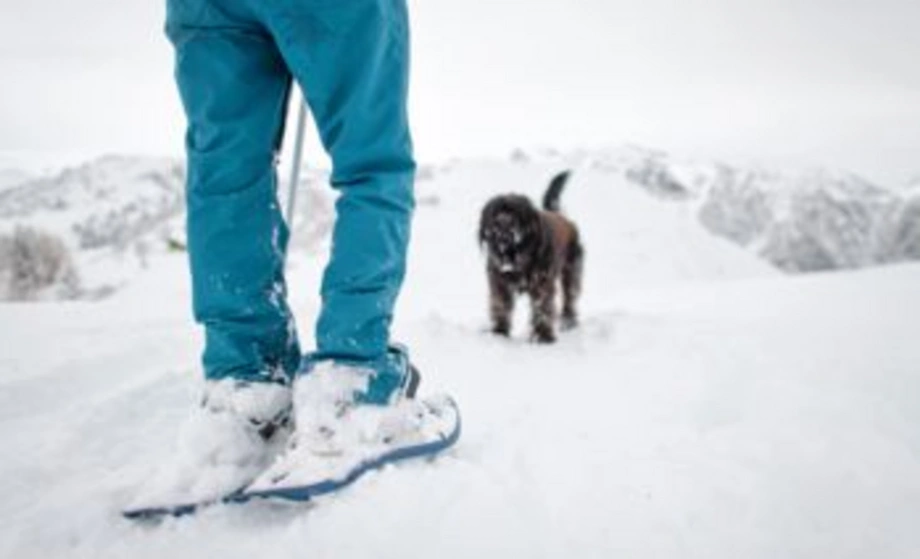
Just put on snowshoes and go? That’s not a good idea with a dog. If you want to take your four-legged friend on a tour of the winter wonderland, you should prepare a little and follow the tips below.
Tip #1: The first time? Better without a dog!
Beginners who have never been on snowshoes before should plan their first tour without their dog. On the one hand, to become familiar with the gear, and on the other hand, to feel first-hand how strenuous snowshoeing can be.
Tip #2: Start slow
Tip #3: The basic dog commands
In the open countryside, your dog must know the common basic commands. If a deer, a fox or another dog crosses your path, the commands “Down”, “Stay”, or “Heel” must be followed reliably. Your dog should not rummage or run far away from you. If all this goes well, then your dog is ready to join you on that snowshoe tour.
Tip #4: Practise command “track” in advance
One problem when walking with snowshoes and on a ski tour is that the dog has to keep its distance from its owner, and it often has to learn that first. Don’t worry: it’s not that difficult; it just requires a little practice and discipline. The command “track” or “distance” must work to protect you and your four-legged friend from injury. However, most dogs understand relatively quickly that it is also best to follow or go ahead in the track at a certain distance.
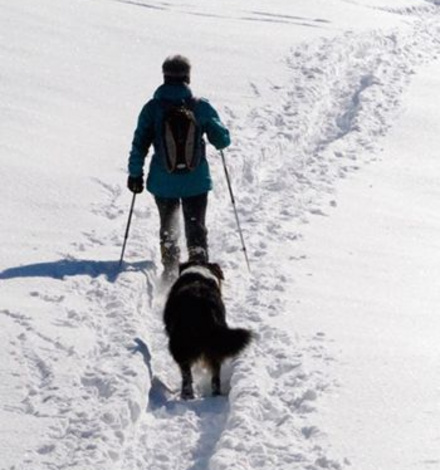
It is important that your dog listens to the command “track” and follows you at a safe distance. You should practise this at home.
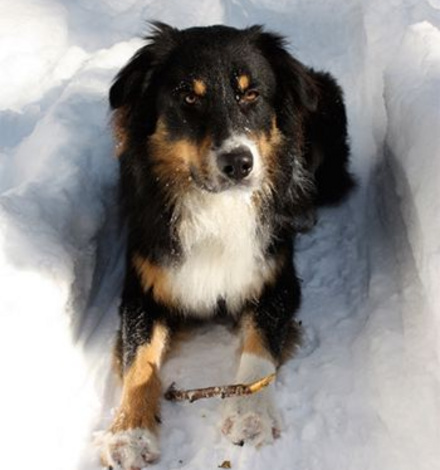
In addition, basic commands such as “Heel!” or “Sit!” are of course also a basic requirement for your dog to be allowed to go on a snowshoe tour.
If your dog has already learned to “track” at a suitable distance behind you, your snowshoe hike together will be much more relaxed. The lurking curve will be rapid most of the time, and the dog will follow in single file behind his human. However, if he runs up too close, he will either step on the back of the snowshoes (danger of tripping!), or he will constantly get snow in his eyes. You also have to watch out for the poles not to injure your dog. Take care not to step on the dog’s paws with the snowshoe crampons.
Tip #5: Bring enough water – also in winter
If you think that your dog can eat enough snow to not get thirsty in winter, you are very much mistaken. The dog needs enough water even in cold temperatures, especially when going on strenuous outings. Many dogs lick or eat snow when thirsty, but unfortunately, they rarely tolerate it. Eating snow can lead to gastrointestinal problems and even more severe illnesses. Drinking water for the dog belongs in your backpack!
Tip #6: Keep snow clumps off the dog’s paws
Tip #7: A snow coat for the dog
Not only on its paws but also in its “armpits”, my long-haired dog (Australian Shepherd) has to struggle with these rock-hard, chafing clumps of snow in certain snow conditions. He visibly suffers from it, literally throwing himself on the ground and trying to remove these troublemakers by gnawing, thoroughly annoyed. This winter, I want to try putting a tight T-shirt on him to prevent the snowballs from forming in the first place – even though it probably looks pretty embarrassing.
By the way, for dogs that are sensitive because of their short hair on the belly or because of back problems, special dog coats (for example from Ruffwear) are very suitable. When taking breaks in the cold wind, not only do humans cool out quickly. Many a dog owner is frozen on some summits because he threw his jacket over his faithful companion who was sitting next to him shivering. This is especially true for young and short-haired dogs.
Tip #8: Keeping your dog’s wellbeing in mind
Especially with young dogs, you have to avoid them catching a cold or overexerting themselves. Often, a dog will fall from exhaustion rather than lose sight of its owner. These almost self-destructive behaviours are typical of animals. Therefore: Pay attention to how your dog is coping with the (unusual) strain of a snowshoe tour.
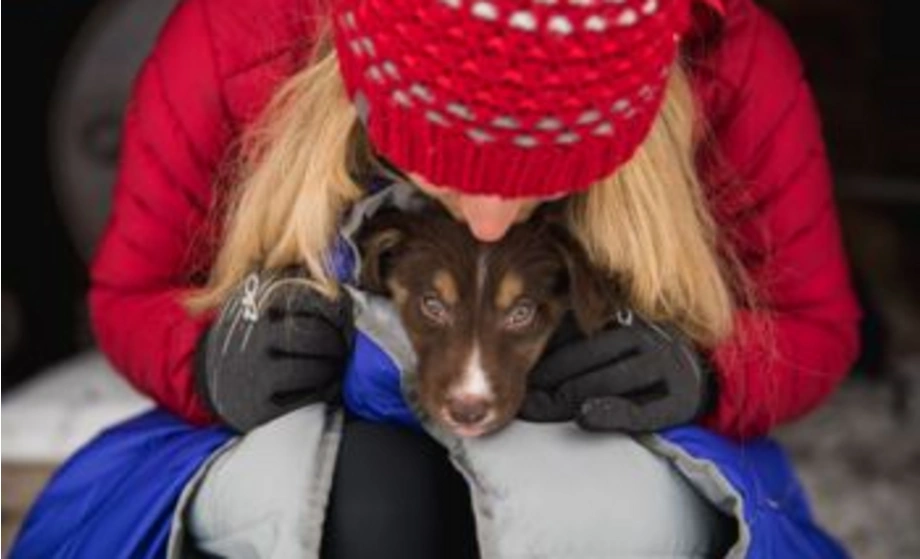
Snuggle up? Young dogs in particular can get cold easily when touring in winter.
Tip #9: The correct planning for a snow tour with a dog
All the same rules and preparation measures apply to snowshoeing with a dog as apply to other winter hikes: Plan your outing according to the weather forecast and avalanche report, plan your time with breaks, take enough warm drinks and snacks in your rucksack as well as a GPS device and suitable maps!
Even on short and seemingly harmless tours, things can quickly look very different in winter due to an emergency. That’s why good planning is always an advantage. When choosing the length and difficulty of your tour, you should consider the following points:
- Condition and surefootedness of all participants
- Condition and physical condition of your dog
- Snow and avalanche conditions
- Weather forecast
Tip #10: Check the avalanche conditions
Anyone who ventures into backcountry terrain with snowshoes must also deal with the issue of avalanches. It is good to know that a dog can represent an additional solid load for a slope as it sinks in significantly deeper concerning the avalanche danger.
In particular, beginners should first undertake experiences in light, safe trails. Anyone who goes into the “backcountry” must know and assess the avalanche situation report. It is also essential to have functional avalanche equipment ( beacon switched on!) with you and to be able to use it. There are also special courses for snowshoe hikers!
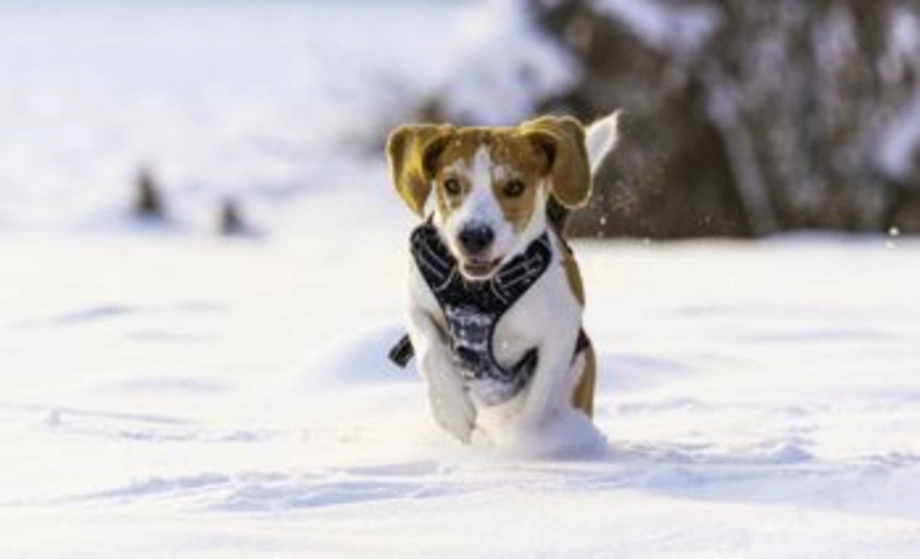
Dogs love snow! On a snowshoe hike with your dog, however, you should not only keep an eye on your dog’s mood, but also on the avalanche situation.
Special features when snowshoeing with a dog
When you go on a tour that is mainly untracked, the joy is, first of all, enormous. My dog is always happy about the thick snow cover, through which he can tear through like a wild beast, and at first, he sprints ahead. However, after a few hundred metres, he realises how exhausting it is, at least when the snow is full-on. After all, the dog has no snowshoes strapped on and has to make his way through the white powder, deep slush, or corn on its tiny paws.
- Bergzeit-Tip: In principle, snowshoeing is an excellent alternative to ski touring, especially for older dogs, because walking is easier on the hips and tendons. When snowshoeing, dogs usually don’t reach their limits so quickly.
Your dog’s physical condition also plays an important role when snowshoeing with a dog: A short-legged dog will have to make a great deal of effort even at lower snow depths. The bigger and heavier a dog is, the deeper it will sink into the snow and have to plough through it with difficulty.
Can you use a pulley system?
If the dog is a breed that likes to pull and run, such as huskies, it can also track in front. In this case, a pull harness and a shock-absorbing leash with a belly strap would be suitable. However, you can also attach the leash to the stable hip belt of the rucksack for the time being – highly practical for steep sections on snowshoe tours, as a well-trained dog can save a lot of your strength.
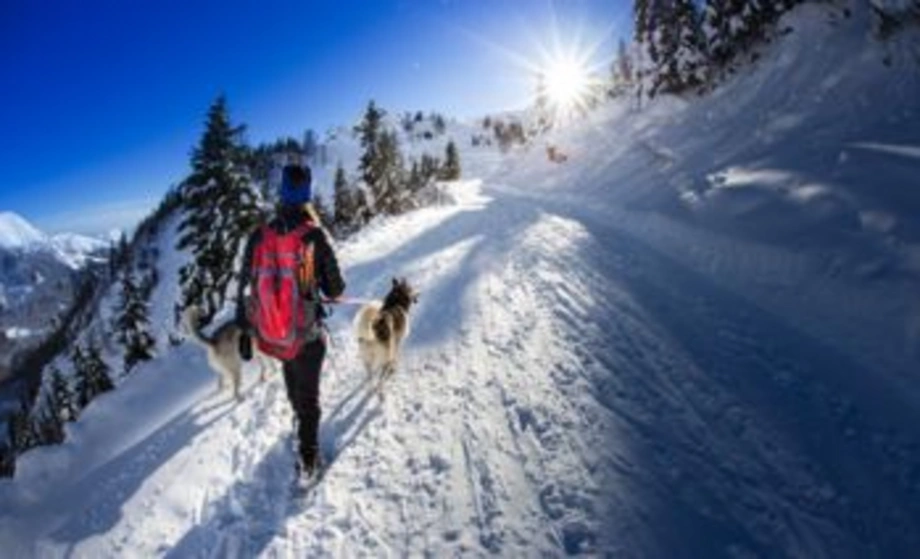
If you are travelling with breeds that like to pull and run, such as huskies, you can also let the dog track in front.
Summary:
- Select the distance and difficulty of the tour according to the condition and surefootedness of group members.
- Take the dog’s condition and its physical requirements into consideration.
- For dogs in poor condition, older or handicapped dogs, the tour should be easy or short.
- Check the avalanche and weather conditions before the tour.
- Observe protection zones for wild animals.
- Start the tour early enough.
- Allow time for long breaks.
- Plan to return in the early afternoon so that you have enough time in reserve before nightfall.
- Make sure you have the right gear.
- Drink enough during the hike.
- Take sunscreen.
